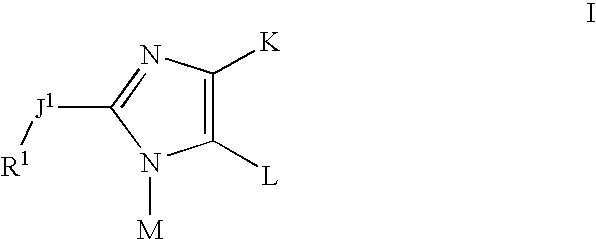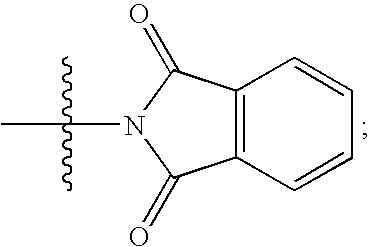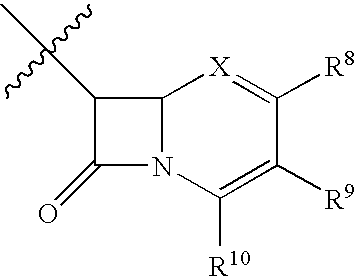Imidazolyl inhibitors of 15-lipoxygenase
a technology of idazolyl and enzyme, which is applied in the field of idazolyl inhibitors of the enzyme 15-lipoxygenase, can solve problems such as serious disorders
- Summary
- Abstract
- Description
- Claims
- Application Information
AI Technical Summary
Benefits of technology
Problems solved by technology
Method used
Image
Examples
example 1
4-Butyl-piperazine-1-sulfonic acid {2-[5-(4-methoxy-phenyl)-2-thiophen-2-yl-1H-imidazol-4-yl]-ethyl}-amide
A. 4-Azido-1-(4-methoxy-phenyl)-butan-1-one
To a solution of 4-chloro-4′-methoxybutyrophenone (Acros Organics) (22.45 g, 106 mmol) in DMF (300 mL) was added sodium azide (13.7 g, 211 mmol). The solution was heated under N2 (g) at 70° C. for 4 h. The milky reaction mixture was partitioned between ethyl acetate (700 mL) and water (500 mL). The organic layer was washed with another portion of water (500 mL), followed by saturated aqueous sodium bicarbonate (500 mL) and brine (500 mL). The organic layer was dried (sodium sulfate) and concentrated to give an oil (22 g, 95% yield) which solidifed slowly upon standing. MS m / e 220; HPLC retention time 3.09 min.
B. 4-Azido-2-bromo-1-(4-methoxy-phenyl)-butan-1-one
To a solution of 1A (21.67 g, 98.9 mmol) in 1,4-dioxane (300 mL) was added bromine (5.07 mL, 98.9 mmol) dropwise. After 20 min at ambient temperature, the reaction mixture...
example 2
C. Example 2
The title compound was prepared following the procedure employed for the preparation of Example 1E from 1D using 2B in place of N-butyl piperazine. MS m / e 532; HPLC retention time 1.17 min (Method A).
1H NMR (CD3OD): δ0.98 (t, 3H), 1.43 (m, 4H), 1.75 (m, 2H), 2.80 (b s, 2H), 3.89 (s, 3H), 7.13 (d, 2H), 7.35 (dd, 1H), 7.62 (d, 2H), 7.92 (m, 2H).
Example 3
A. (R)-N-[1-(4-Fluoro-benzyl)-2,5-dioxo-pyrrolidin-3-yl]-acetamide
Following the method of Witiak et al. (J. Med. Chem., 1971, 14(1), 24-30), N-acetyl-D-aspartic acid anhydride (2.19 g, 13.9 mmol) and para-fluorobenzylamine (1.74 g, 13.9 mmol) in acetone (12 mL) were heated together in a sealed tube at 100° C. for 1 h. The solvent was then removed under reduced pressure. Acetic anhydride (15 mL) was added to the residue and the mixture heated 50 min. at 100° C. The solvent was removed under reduced pressure and the residue purified by flash column chromatography (silica, 10% methanol in dichloromethane) to give the pr...
example 3
The title compound was prepared following the procedure employed for the preparation of Example 1E from 1D using 3B in place of N-butyl piperazine. MS m / e 584; HPLC retention time 1.98 min (Method A).
1H NMR (CDCl3): δ0.98 (t, 3 H), 2.0-2.2 (m, 2H), 2.85-3.1 (b m, 4 H), 3.25 (b dd, 2 H), 3.45 (s, 3 H), 3.63 (b s, 2 H), 4.0-4.15 (m, 3 H), 4.50 (b s, 1 H), 6.82 (b d, 2 H), 6.95 (b m, 3 H), 7.35 (b m, 4 H), 7.44 (b s, 1 H), 7.87 (b s, 1 H).
PUM
| Property | Measurement | Unit |
|---|---|---|
| Electric potential / voltage | aaaaa | aaaaa |
Abstract
Description
Claims
Application Information
 Login to View More
Login to View More - R&D
- Intellectual Property
- Life Sciences
- Materials
- Tech Scout
- Unparalleled Data Quality
- Higher Quality Content
- 60% Fewer Hallucinations
Browse by: Latest US Patents, China's latest patents, Technical Efficacy Thesaurus, Application Domain, Technology Topic, Popular Technical Reports.
© 2025 PatSnap. All rights reserved.Legal|Privacy policy|Modern Slavery Act Transparency Statement|Sitemap|About US| Contact US: help@patsnap.com



